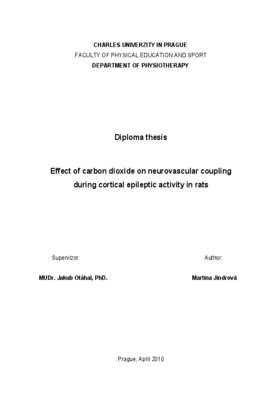Effect of carbon dioxide on neurovascular coupling during cortical epileptic activity in rats.
Účinky oxidu uhličitého na neurovaskulární spojení během epileptické kortikální aktivity u potkanů
diplomová práce (OBHÁJENO)

Zobrazit/
Trvalý odkaz
http://hdl.handle.net/20.500.11956/21716Identifikátory
SIS: 85141
Kolekce
- Kvalifikační práce [8709]
Autor
Vedoucí práce
Oponent práce
Brožíčková, Carole
Fakulta / součást
Fakulta tělesné výchovy a sportu
Obor
Fyzioterapie
Katedra / ústav / klinika
Fyzioterapie
Datum obhajoby
12. 5. 2010
Nakladatel
Univerzita Karlova, Fakulta tělesné výchovy a sportuJazyk
Angličtina
Známka
Výborně
Aim: The aim of the study is to investigate the effect of CO 2 on neurovascular coupling in response to epileptiform activity after trancallosal electric stimulation in rats. Methods: Adult albino rats (250-350g, n=6) were anaesthetized with isoflurane and epidural silver EEG electrodes were implanted and fixed into the skull over sensorimotor cortices. To measure regional cerebral blood flow (rCBF) during epileptic activity a self-made metal holder for Laser Doppler Flowmeter (LDF) probe was fixed to thinned skull with dental acrylic. To measure arterial blood pressure (BP) and arterial blood gasses a plastic catheter was implanted into the common carotid artery. After postsurgical recovery animals were placed in a recording chamber. After 20 minutes of background recording effect of CO 2 on basal BP an rCBF was tested by inflating a mixture of 10%CO 2 , 20%O 2 and 70%N 2 for 30seconds. To assess changes in neurovascular coupling a rat model for myoclonic seizures was used. Biphasic constant current suprathreshold stimulus (8Hz, 15s) was applied under normal or elevated CO 2 atmosphere. Results: Elevated CO2 led to a significant increase of both regional cerebral blood flow and blood pressure. In addition, inhalation of 10%CO2 during electrical stimulation of senzorimotor cortex (8Hz, 15s) caused...
Aim: The aim of the study is to investigate the effect of CO 2 on neurovascular coupling in response to epileptiform activity after trancallosal electric stimulation in rats. Methods: Adult albino rats (250-350g, n=6) were anaesthetized with isoflurane and epidural silver EEG electrodes were implanted and fixed into the skull over sensorimotor cortices. To measure regional cerebral blood flow (rCBF) during epileptic activity a self-made metal holder for Laser Doppler Flowmeter (LDF) probe was fixed to thinned skull with dental acrylic. To measure arterial blood pressure (BP) and arterial blood gasses a plastic catheter was implanted into the common carotid artery. After postsurgical recovery animals were placed in a recording chamber. After 20 minutes of background recording effect of CO 2 on basal BP an rCBF was tested by inflating a mixture of 10%CO 2 , 20%O 2 and 70%N 2 for 30seconds. To assess changes in neurovascular coupling a rat model for myoclonic seizures was used. Biphasic constant current suprathreshold stimulus (8Hz, 15s) was applied under normal or elevated CO 2 atmosphere. Results: Elevated CO2 led to a significant increase of both regional cerebral blood flow and blood pressure. In addition, inhalation of 10%CO2 during electrical stimulation of senzorimotor cortex (8Hz, 15s) caused...
